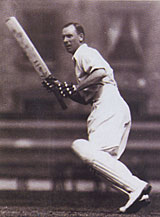
|

The two-day experiment did not seem to bother Jack Hobbs who resumed where he had left off before the war as the season's leading run-scorer
© Getty Images
|
|
Cricket's administrators have never been frightened to experiment, and that particularly applies in England where the County Championship is concerned. Over the last three or four decades the points structure has varied from the confusing to the downright incomprehensible; pitches have been uncovered and covered, one division has become two, first innings have even been limited to set overs; and the season has been so far stretched that it runs from the freezing early April to chilly late September.
But one of the most bizarre instances of tinkering for the sake of it came in 1919. First-class cricket had been suspended since August 1914, and after the end of the Great War all people wanted was a return to normality and familiarity. Sadly, the authorities thought otherwise, and came up with the idea of reducing Championship matches from three to two days.
That was one of a number of changes thrown into the melting pot. Others, which were rejected, included starting games at 2pm and running through to 8pm (there was still double daylight savings so the light was not an issue), seven or eight-ball overs (the latter was introduced for one season in 1939), shortening boundaries ... even banning left-hand batsmen.
In December 1918, the MCC Advisory Committee, largely because of the backing of Middlesex, agreed to two-day matches, with playing hours from 11.30am through to 7.30pm. While the authorities stopped short of cancelling lunch, tea was done away with, the decision being that "tea or other refreshments could be brought onto the ground". While that might sound rather drastic, it was in fact a reversion to the way things had been done in the late nineteenth century. Fortunately for the players, this aspect of the planned proposal was scrapped when the MCC Advisory Committee met in February 1919.
The confusion was increased by the fact that only Championship matches were reduced to two-day affairs. All other games - and in those times there were many, such as Gentlemen v Players, that were considered more important - remained of three-day duration within conventional hours. So MCC hosted a three-day game against Yorkshire at Lord's, and yet the more popular Championship clash between Middlesex and Yorkshire on the same ground, only lasted two.
 One season's experience is all that is needed to prove the folly of the two-day scheme
One season's experience is all that is needed to prove the folly of the two-day scheme
 The prescient Lord Harris before the start of the 1919 summer
|
Some establishment figures were against the idea from the off. Lord Harris, cricket's senior statesman, said that "one season's experience is all that is needed to prove the folly of the two-day scheme." In the 1919
Wisden, the editor wrote: "I have a very strong opinion that a grave mistake has been made in not letting the game alone. The restriction of all county matches to two days strikes me as being a sad blunder."
In June, six weeks into the experiment, the Times reported that the changes had proved fairly popular with the spectator but less so with the players. It added that while most spectators had left the ground long before the 7.30pm close, "the player must wait till the end." It continued: "The spectator can leave the ground to be home for dinner, the theatre, picturepalace or music hall, just as he pleases." Players were rarely home before 9pm - this was, after all, the era of total reliance on public transport or walking. "This is making the game too much of a business for the amateur, too hard a life for the professional."
Those views appear to have reflected the general feeling. That the whole summer was not reduced to farce - the shortened games were at the mercy of the elements - was largely because of the fact that the weather remained fine almost throughout.
Wisden in 1920 reported that the scheme "was doomed before half the season was out." The editor continued: "The players and the umpires hated the long days and the public assuredly did not like them. Only when something quite out of the common was to be seen did any great number of people wait on the ground till half-past-seven. Before that time the craving for food had as a rule become stronger than the passion for cricket. To put the matter in a prosaic way, the advocates of the two-day match overlooked the needs of the human stomach."
Although the few advocates pointed out to increased attendances, despite entry charges doubling to allow for the new Entertainment Tax, it was clear that this owed more to the public being starved of the game - and the days of sunshine - than anything else.
On August 19, the Advisory Committee decided to scrap the unloved venture. The Times dryly noted that "those who had clamoured most loudly for the experiment were among the first to realise it could not be repeated."
Is there an incident from the past you would like to know more about? E-mail us with your comments and suggestions. Bibliography
The Cricketer - Various
Wisden Cricketers' AlmanackVarious
The Times Various
The Daily Telegraph Various
Martin Williamson is managing editor of Cricinfo.
